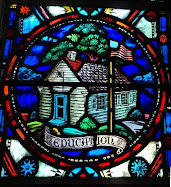Children are born storytellers, always looking for an audience with which to share their newest inspirational plot. It is the telling and retelling of stories through creative puppetry, pretend play, and flannel graph which helps children meet and understand storybook characters. Through their acting and imaginative play, children engage themselves physically, mentally, emotionally, and socially in the learning process.
Think back to the stories of your childhood. What do you recall about the stories that impacted you most? Did you act out your stories? Did you create a puppet? Did you dress the part of a character and perform for friends and relatives? Did someone tell you the story with flannelgraph characters? The list of questions can be endless, but the answers are often linked to a person's memories of multi-sensory, literary experiences. Puppets allow the written word to take on an exciting, new dimension. Storytelling and pretend play, when complemented with puppets and theatrics, can speak to the heart and soul of the child.
Puppets are a valuable treasure for a young child. Puppets can read a book, talk to an audience, encourage a friend or teach a new skill. Understanding the value of puppetry, many publishers are currently marketing children's stories with an accompanying puppet. These puppet and book packages can be found at an educational learning store or local bookstore.
Finger Puppets
Young children love finger puppets, perhaps because the puppets can be worn all day and do almost anything. They wonder into laundry baskets and travel many miles in the car. Moms reminisce about finding a child cuddled up in the corner talking to her small storybook friends, unknowingly practicing conversational skills.
Finger puppets are cherished for their versatility and mobility.
Making finger puppets with your children can be rewarding. One of the quickest, easiest finger puppets to construct is the gingerbread man (good thing he runs through a classic tale). Cut out a gingerbread friend from construction paper to fit your child's finger (or trace a cookie cutter gingerbread man onto paper and cut it out). Tape the gingerbread man to a paper cylinder, fitting the circumference of your child's finger. If one finger puppet isn't enough, purchase gardening gloves at the dollar store and make a puppet for each finger. Add pom-poms and puff paint features. Puppets in hand, literally, your child will tell the story of the Gingerbread Boy over and over.
All Kinds of Puppets
Children of all ages enjoy making puppets of their own, personalizing faces and clothing. Puppets can be made from a wooden spoon, a sock, a discarded pair of pantyhose, a Popsicle stick, or a small brown paper bag. Hand puppets can be cut from felt and sewn or hot glued together.
Resources
For the parent who wants to make puppets with children, resources abound. Many helpful books are available at the local library. Check out:
- Clap Your Hands: Finger Rhymes chosen by Sarah Hayes
- Eye Winker, Tom Tinker, Chin Chopper by Tom Glazer
- Little Hands Fingerplays and Action Songs: Seasonal Rhymers and Creative Plays for 2-6 Year Olds byEmily Stetson and Vicky Condgon
On the Internet visit http://www.sagecraft.com/puppetry/
Happy puppet making!

















No comments:
Post a Comment